INDIAN RAMBLE 2011-12
Part 7 Bodhgaya
Bodhgaya
Although the Mahabodhi Express was to arrive bright and early at 5:50 a.m.,
it seemingly “slept in” and arrived five hours late. Perhaps fog, a common
problem in north India’s winter, had delayed the train. From Gaya, my autorickshaw headed out amidst a cacophony of deafening horns and bounced across
broken pavement for the 15 kilometers to Bodhgaya. On arrival I grabbed a hotel
room and a very late breakfast, then set off to circumambulate the Mahabodhi
Temple, a pyramidal spire of 50 meters that houses a gilded statue of the
Buddha. Next to the temple, a red sandstone slab placed by Emperor Ashoka marks
to spot where the Buddha realized Enlightenment after striving to discover
the “Deathless.” A descendent of the original Bodhi Tree that the Buddha sat
under during his meditation now shades the spot. Large groups maroon-clad Tibetan monks and
their lay supporters had gathered on the temple grounds to chant or meditate at
this, the most sacred place for Buddhists. Thousands of Tibetan monks from India
and beyond gather here each winter, and not just for the agreeable climate. The
Dalai Lama had been here a month ago to lead important Kalachakara teachings,
and now the 17th Karmapa, Ogyen Trinle Dorje, was here to give teachings. A
constant low drone of Tibetan chants rose from the temple grounds. Groups of
Thais, led by a monk or layperson with a portable amplifier, added a very
different sound with their high-pitched Thai chanting.

The Mahabodhi Temple’s entrance faces to the east. The “Diamond Throne” that
marks the spot
where the Buddha sat under the Bodhi Tree and realized Enlightenment is on the
other side of the temple.

On the temple grounds: A man waters flowers placed in little cups on the left; a
group of
Sri Lankan monks rest in the center; and Tibetan monks read or chant on the
raised platform on the right.
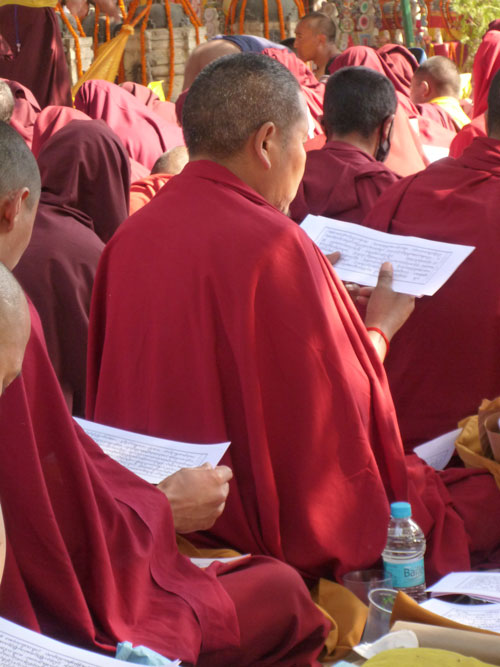
Tibetan monks chanting

Rose petal
offerings

Water lily and marigolds
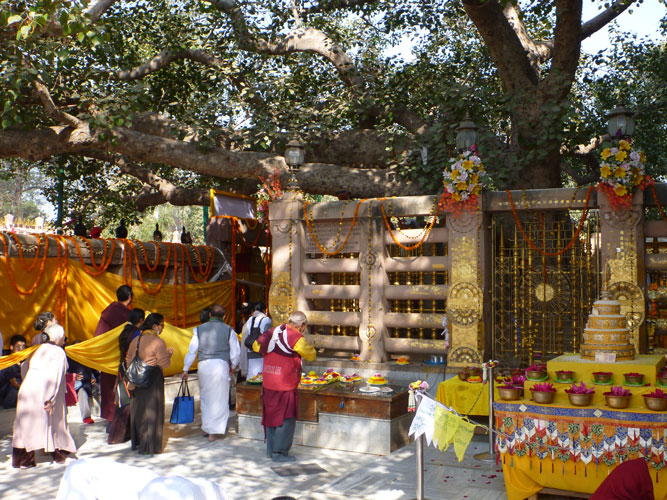
Stone and brass railings enclose the Buddha’s “Diamond Throne”
and a descendent
of the original tree under which the Buddha sat.

The “Diamond Throne”

The Bodhi Tree

Thousands of lamps burn in special buildings near the temple.

A Tibetan nun feeds a super-sized incense burner in front of two lamp houses.
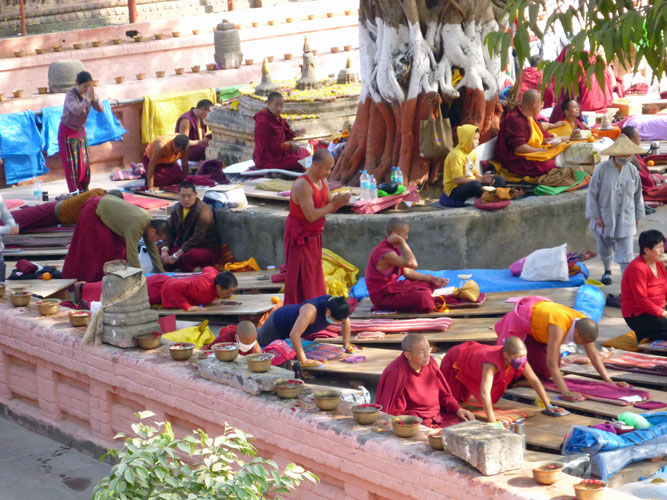
Tibetans are big on prostrations, which start from a standing position.
A Vietnamese nun on the right wears a gray suit and trademark conical hat.
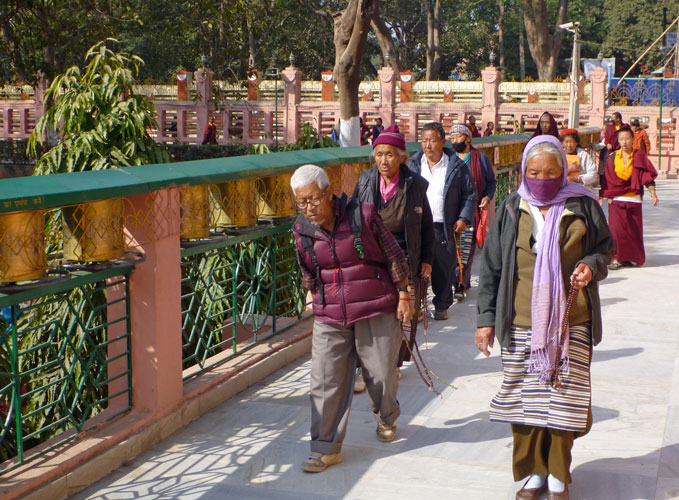
Tibetans like to circumambulate Mahabodhi Temple.

Thais like to travel in groups. Often lay people will dress in white when
visiting a temple.
Twenty-four years ago I had come here on a pilgrimage to all four of the
major Buddhist sites and many of the minor ones. At that time I attended a
meditation retreat led by teacher and former monk from the U.K., Christopher Titmuss.
And now he is here again, for his 38th Bodhgaya retreat! I
dropped in one day to hear his talk on how to counter the Five Hindrances to
meditation (sense desire, aversion, sloth & torpor, restlessness & worry, and
doubt). See http://bodhgayaretreats.org/
for information on Christopher’s retreats and teachings.
On my second evening, I joined a crowd at an outdoor stage for a Buddhist
cultural program with a mix of graceful traditional and lively contemporary
dances and songs. Performers included Sri Lankan schoolkids, Thai university
students, Sikkimese from northern India, and Bhutanese. Dancers from Bhutan
dressed in colorful and elaborate costumes, sometimes with masks, for
mesmerizing religious dances in which they slowly twirled around and kicked high
into the air to the sounds of drums and gongs. A Tibetan man sang a song about
the Tibetan plight under Chinese occupation to an appreciative audience. Lastly,
a regional theatre group portrayed major events in the life of the Buddha;
although the play was in Hindi, I could easily follow along.
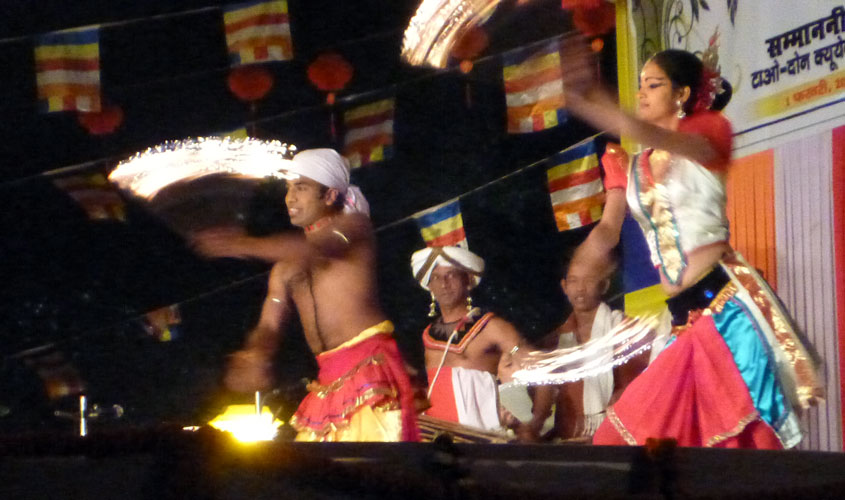
Sri Lankan dancers playing with fire

The last act: A dying Buddha gives his final words to grief-stricken monks.
Bodhgaya is a bit like a religious shopping center in which one can visit
temples and meet people from all the major Buddhist traditions. Thailand has the
grandest temple, a traditional structure with lots of glittering glass tiles and
gold paint on the exterior and an elaborate altar with Buddha statues and a
photo of the king on the interior; also inside, wall paintings depict
traditional Buddhist stories and Thai life; I was told that about 40 monks and
nuns reside in the surrounding buildings. Nearby, the modest-sized temple from
Bhutan contains flamboyant decorations inside and out in a Tibetan style. In
contrast, the neighboring Japanese temple exudes calm with its white walls and
dark wood. The Tibetan temples seemed the busiest with chanting monks and crowds
of pilgrims.

A cycling Buddha?
This statue rests on a a well decorated cargo cycle outside the Sri Lankan
Mahabodhi Society building.

A setting sun illuminates the back of the Thai temple.

Angels above and chief disciples below flank the Buddha in the Thai temple.
A
photo of the king of Thailand is on the left.

Inside the Thai temple, a boat succumbs to a stormy sea and fierce fish in a
depiction of a story about the Buddha in a previous life. He survives the
ordeal.

On the Thai temple grounds, I encountered this procession led by musicians and
dancers.
A group of women at the rear brought gifts for the abbot.

A dancer in the Thai procession

More dancers
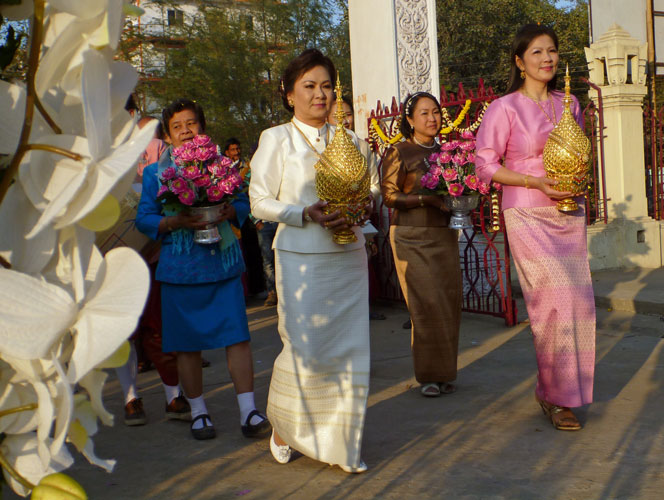
Bearing ceremonial gifts

A fierce guardian protects the south side of the Bhutanese temple.
The wall in the foreground belongs to the Japanese Indosan Nipponji Temple.

A Buddha presides midst a cornucopia of colorful decorations in the Bhutanese
temple.
I think that’s the famous Tibetan teacher Guru Rinpoche on the left and the
future Buddha Maitreya on the right.

A raised-relief decoration inside the Bhutanese temple.
Could this scene depict the death of the Buddha’s mother?
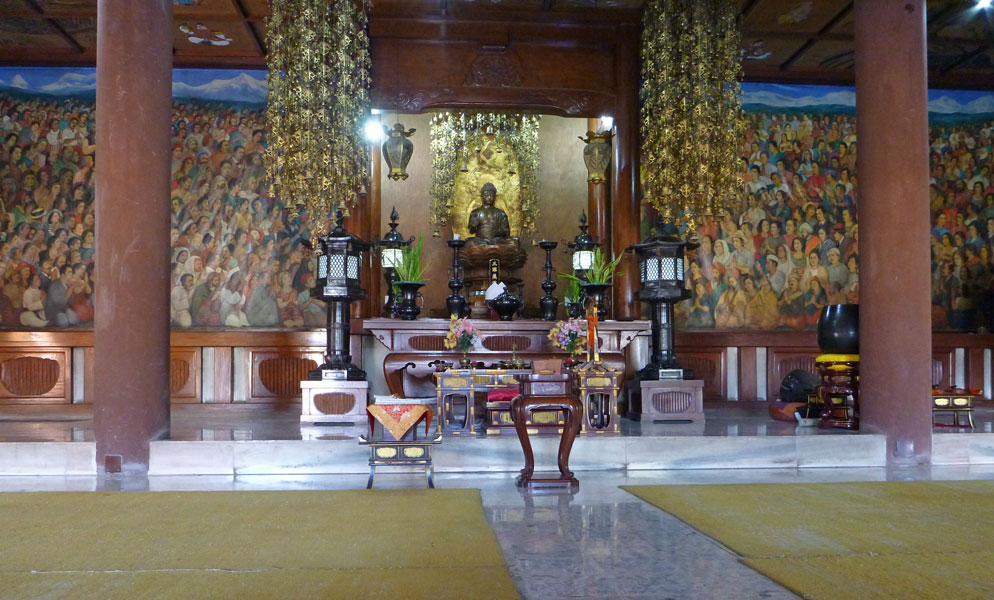
Murals provide an audience for a Buddha in the Japanese Indosan Nipponji Temple.
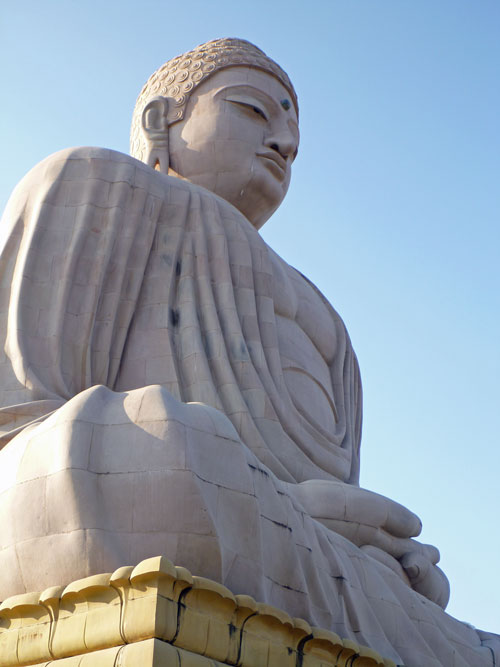
The Great Buddha Statue towers 25 meters.
The Daijokyo Buddhist Sect sponsored the statue, then the Dalai Lama unveiled it
in 1989.
I found religious places, especially the Mahabodhi Temple, delightful to
visit. On the other hand, the rest of Bodhgaya is literally a dump. Pigs, dogs,
and cows root through piles of trash and garbage beside the village lanes. Pools
of sewage lie here and there, adding to the stench. Heavy traffic clogs the main
road, churning up clouds of dust and leaving no place to walk. Many visitors
wear surgical masks, probably a good idea. I stayed healthy, but could feel that
my body was stressed from the pollution.
On the last night, I entered an enormous tent for the Buddha Mahotsav, a
major annual cultural cultural event. It opened with a flamboyant presentation
by all the performers, including Sri Lankan fire dancers. Next, Tibetan monks
chanted in very low double tones, followed by chants from a group of Theravadan
and Mahayana monks. Chief Minister Nitish Kumar of Bihar state and a few other
high-ranking politicians helped inaugurate the festival by giving speeches,
though all these were in Hindi. I read in a newspaper the next day that the
Chief Minister had “exhorted the people of the region to imbibe the spirit of
Buddhism and follow Buddha’s footsteps.” The Chief Minister also addressed
practical issues, noting the success of the local international airport and
promising an upgrading of the road between Bodhgaya and Gaya; he also “pulled up
the local officials for poor sanitary conditions and said that a foreign tourist
complained about the poor waste disposal mechanism.” (If that tourist had been
me, I would have complained about NO waste disposal mechanism!) The Karmapa gave
a short talk in a mix of Tibetan and English about peace, compassion, and wisdom
of the Buddhist teachings. Finally the main program got underway with cultural
groups from Ladakh, Sikkim, Bhutan, Sri Lanka, and Thailand. As at the
smaller-scale performance of two nights ago, I found the religious dances of the
Tibetan-influenced Himalayan regions the most entrancing. Energetic contemporary
Sri Lankan dances reminded me of Indian Bollywood hits. The Thais had by far the
most graceful dance movements, including elaborate finger positionings.
The Buddha Mahotsav was to run two additional nights with the Day Two program
by Bihar artists and Day Three dedicated to a variety of Indian music
traditions. But I had a train to catch, the Poorva Express, bound for Kolkata. I
bounced my way in an autorickshaw back to the Gaya train station and had plenty
of time for breakfast there as the train was running about an hour late. As on
the ride to Gaya, I had a comfortable seat in a two-tier air-conditioned car.
The window was too opaque to see out of, as is often the case on Indian
air-conditioned trains, so I mostly just read the newspaper and listened to
stuff on my iPod.
On to Kolkata
Back to the Beginning of Indian Ramble



























